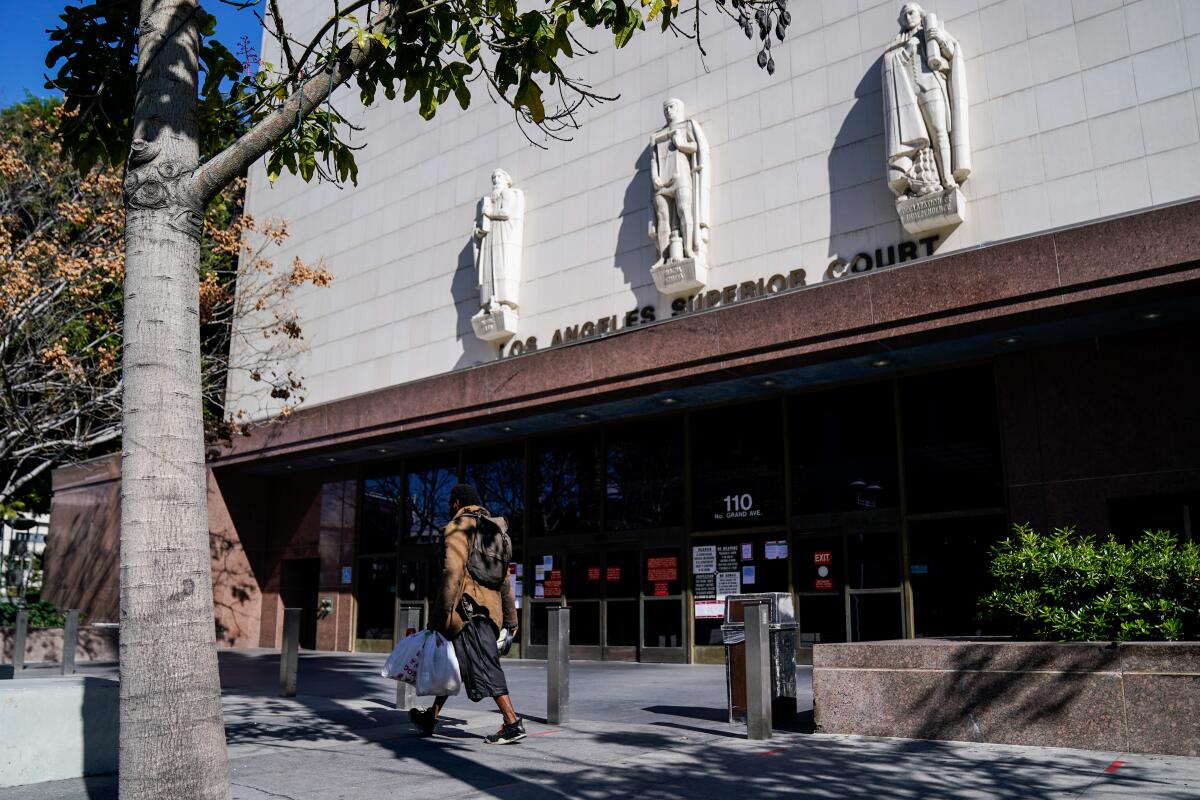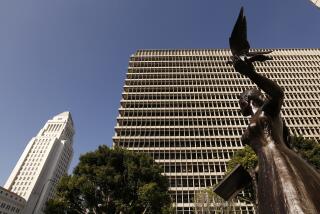What happens when COVID shuts civil courts?

It was a question of what would happen first for the Los Angeles hotel owner whose business had been decimated by the coronavirus lockdown: a financial settlement with the angry employees he had fired — or bankruptcy.
Across town, a Black man wanted to fight his recent termination, contending it was because of racial discrimination not a coronavirus-related business downturn. In another case, a woman suddenly out of work was ready to accuse her boss of using pandemic layoffs to cover up his sexual harassment.
Employers were wrangling with workers claiming extended paid sick leave when they hadn’t provided proof that they had contracted COVID-19. And former employees were asserting that bosses were using pandemic business losses as an excuse to settle scores and selectively fire those they considered difficult.
All are real examples from the last six months — with names and details removed to protect client privacy — that employment lawyers, mediators and arbitrators cite for why they are more busy than ever since coronavirus protection measures upended workplaces and left California courthouses largely empty.
But having to rely on mediation and arbitration to resolve cases has left many people in a terrible position, consumer and personal injury attorneys say, contending that such alternative dispute resolution favors corporations and employers.
Civil trials, particularly in the largest counties, have been postponed, perhaps for months, leaving employment and other disputes in limbo.
Presiding Los Angeles County Superior Court Judge Kevin C. Brazile issued an order Thursday saying the court will prioritize criminal jury trials as it works to expand operations and must postpone all civil jury trials until January.
Businesses fear they’ll be blamed for COVID-19’s spread. They’re fighting for measures to protect them from lawsuits over infections, hospitalizations and deaths.
In early September, the court completed its first criminal jury trial since the shutdown, and more than 7,000 criminal cases await trial to satisfy the defendants’ right to a speedy trial, he said. Small claims cases and nonjury traffic cases resumed in August.
For six months, attorneys and human resource experts say, pandemic-fueled confusion and a sense that rules no longer apply have been crashing into the reality of California labor, workplace safety, consumer protection and other laws, some of which have been strengthened since March, such as ordinances governing worker right of recall and retention adopted recently by Los Angeles city and county.
“The COVID made me do it” is the ultimate scapegoat nowadays claimed by either side in employment litigation, said Coby Turner, a Sacramento attorney who represents employers for international law firm Seyfarth Shaw.
Before the novel coronavirus, lawyers would often hash these matters out before a judge or jury. They would at least use the threat of a reasonably quick court date to force a solution.
But with some courts just beginning to ramp up operations, alternative forms of dispute resolution are booming in California and other hard-hit states. Face-to-face negotiations with mediators or arbitrators — known in legal circles as “the neutrals” — mean dueling videoconference screens as remote work remains the norm.

“When you are faced with the possibility that you won’t get on a court calendar for two, possibly three years, you’re not going to want to wait that long,” said attorney Angela Reddock-Wright, a panel member for dispute resolution company Judicate West and managing partner of Reddock Law Group, which mediates and arbitrates disputes between employers and employees and investigates workplace claims on behalf of business, education and government clients.
“I’ve had to add Saturday hours and offer meeting times that run to 11 p.m. on weeknights, just to keep up. I’m having to turn down investigation cases,” said Reddock-Wright, who is immediate past president of the Southern California Mediation Assn.
Reddock-Wright wears many “neutral” hats, and can serve as a mediator, an arbitrator or a workplace investigator. Her mediation business has jumped 50% over 2019, Reddock-Wright said.
Seyfarth Shaw has been tracking COVID-related labor and employment litigation for the last few months, and Turner said the firm is seeing as many as 50 new lawsuits a week nationally, with California having the largest share.
A widely cited tracker by law firm Hunton Andrews Kurth shows California plaintiffs filed 662 COVID-related lawsuits through Sept. 8, with 93 involving labor and employment, including exposure to the novel coronavirus at work. Nationwide, the total was 4,813 lawsuits, of which 553 were categorized as labor and employment, according to the tracker.
In the midst of the pandemic, business operators are struggling to figure out what they are allowed to do to survive.
Normally, the Society for Human Resource Management, the nation’s largest human resources membership organization, fields about 50,000 calls for information annually. In 2020, that figure is expected to reach as high as 75,000, according to Amber Clayton, director of the society’s Knowledge Center.
Among the most common questions from both employers and workers: Can employees refuse a recall to work and still collect unemployment? Can we keep furloughed or laid-off employees on our group health plan? Are employers able to reduce exempt employees’ salaries because of the business impact of the coronavirus? How can a company conduct a layoff or reduction in force? Can employers demand COVID-19 test results? How can a company help employees navigate unemployment during COVID-19?
“This is uncharted territory,” Clayton said.
The COVID-19 pandemic is unleashing a wave of labor unrest harnessing front-line workers’ fear and anger across California and the nation.
Non-COVID civil disputes haven’t stopped developing during the pandemic, and the courts’ normally heavy caseload — California Superior Courts had more than 665,000 civil cases filed in fiscal 2018 — means an unprecedented logjam has developed.
With jury trials out until next year for civil cases, “all of the cases scheduled for trial between March and December are going to need to be rescheduled,” said Mark Lemke, president of the Southern California Mediation Assn. “All of the trial dates on calendar between January and December of next year may be looking at having those dates vacated or continued.”
Some court systems are worse than others, Turner said, singling out the Los Angeles County Superior Court as one of the laggards.
“Most of the courts I work in are developing Zoom-type systems, doing a lot more telephonic hearings. Some courts have even developed distance jury trials where they have people via Zoom,” Turner said. “So this has been a baptism by fire.”
Brazile said pandemic closures pushed Los Angeles County Superior Court staff to accelerate the adoption of technology for remote visual and audio appearances, squeezing 18 months of work into three. Remote options are now available but can’t be mandated, he said.
There are two kinds of alternative dispute resolution that don’t involve full-fledged court hearings: mediation and arbitration.
A mediator serves as an impartial party to help both sides forge an agreement to keep a matter out of the courts. Without agreement, there’s no resolution.
Arbitration — either nonbinding or binding — usually is ruled over by a judge or a retired judge, attorneys and perhaps an expert in the field of the case involved. There can be one arbitrator or a panel of three, which makes the decision on the case.
In nonbinding arbitration, either side can reject the decision and request a trial. In binding arbitration, the decision is final.
Arbitration becomes controversial when aggrieved employees find that among the documents they signed when hired was an agreement to go to arbitration to settle disputes rather than sue. California companies often have mandatory arbitration rules, signed during the onboarding process, Reddock-Wright said, although the employer is supposed to pay arbitration costs.
Arbitration agreements also appear frequently in consumer contracts.
Having to rely on mediation and arbitration to resolve cases has left many plaintiffs in a painful limbo, said Oakland attorney Micha Star Liberty, president of Consumer Attorneys of California. Liberty’s law practice represents people whose claims include wrongful termination from work, sexual harassment and serious injury or abuse.
“Regular folks who depend on an ability to petition the courts to remedy wrongdoing are in dire straits,” Liberty said.
“Systems like arbitration favor corporations and are extremely expensive. Mediation is extremely expensive,” she said. “With the courts failing to function at full capacity, delay and denying tactics are working and people are getting hurt.”
Lemke, who is handling the mediation between the hotel owner and the former employees, said that the cases can be complicated.
“The defense counsel for the hotel owner said that they needed for me to give them a few minutes for a call in the afternoon. And I said, no problem,” Lemke said. “It turned out that they were also talking to bankruptcy counsel about a possible bankruptcy filing. That gives you a little bit of a sense of how the economic climate is playing out in mediation.”
“A lot of employers,” he said, “who are having economic difficulties are saying, ‘Take an amount of money now and know that you’re going to get it or you can stand in line with a bunch of creditors and even after having fought this thing out for a year or two years, three years, you may not actually wind up recuperating anything.’”
Consumer attorney Liberty said civil trial delays are serious enough to demand legislative hearings to consider ways to force the courts to respond more quickly to the backlogs.
“We are hearing about strenuous attempts to pressure parties to accept whatever offer is on the table,” she said. “So people who have been harmed or fired through no fault of their own or have had their civil rights violated have a Hobson’s choice of settling for little or nothing of what they deserve. It’s really grotesque.”
California and the Trump administration issued protections this week that keep many tenants from losing their homes
Many mediators and arbitrators aren’t expecting the courts to bounce back to their pre-virus pace anytime soon, and they’re convinced their business has gained permanent growth.
Mediation, they say, has easily made the transition to electronic videoconferencing on such platforms as Zoom, Reddock-Wright said.
“With the court systems being backed up for at least a year or two years in some instances, before cases are able to get to trial, I’m glad that we have this option. These cases aren’t just sitting, waiting for the court system to be able to accommodate,” she said.
“We’re getting cases resolved and allowing folks to be able to move on with their lives,” Reddock-Wright said.
At least one mediator-arbitrator said she is able to do a better job through videoconferencing.
Documents are easy to examine closely on one video screen while another is reserved for the people in the mediation or arbitration meeting, said Laura A. Kaster, who practices in New Jersey and New York and is a fellow in the College of Commercial Arbitrators and an executive committee member of the National Academy of Distinguished Neutrals.
Although Kaster can’t walk up to a witness or plaintiff and stand inches away to analyze each facial expression and tic that might help establish whether a person is telling the truth, she can in a Zoom meeting.
“The screen that I have is closer to me than I would be to a witness,” Kaster said.
“There’s less distraction around and I can see and hear very well. And I personally think I see and read the body language just as well,” she said. “In many ways, it’s helping me do a better job.”










